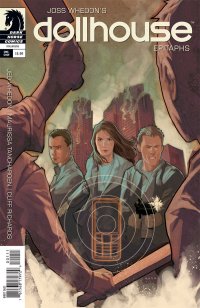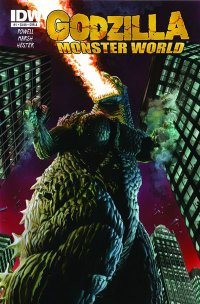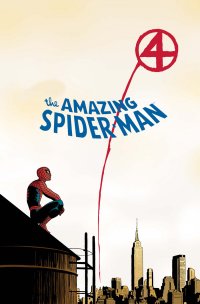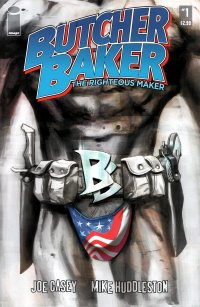Dollhouse: Epitaphs One-Shot, Dark Horse, $3.99
By Adam Prosser
Sometimes a story that starts out as one thing ends up as something very, very different. This is particularly true in the case of serialized storytelling, like TV and comic books. A change in the author’s interest, fan reaction, a shuffling of creative personnel, uncertainty about exactly how much space a storyteller will be allowed before having to wrap everything up—all of these things can have a major impact on the shape of a long-form story. The short-lived TV show Dollhouse suffered from all of them, but the very strange form into which the show eventually evolved doesn’t actually seem to have been affected by any of these external factors so much as the creators’ willingness to follow the implications of their premise all the way to the end.
From the beginning, Dollhouse was an odd show. Begun as a vanity project for Eliza Dushku, created by fan uberfavorite Joss Whedon (though Whedon himself only wrote a couple of episodes and seems to have left much of the creative control to his brother Jed and writing partner Maurissa Tancharoen), Dollhouse started out rather unpromisingly as a show about a girl who had her memories and personality stripped out and replaced on a regular basis by the titular Dollhouse, a covert and quasi-legal business that provided people to order (usually as sleeper assassins or prostitutes). Between the ethical ambiguity, the uneven tone, and the fact that its protagonist was, by design, a literal cipher, the show had trouble finding an audience, even among Whedon’s passionate fanbase. But as the show went on, it not only found its footing, but explored its premise in surprisingly daring ways, in the process mutating into an entirely different show.
(The following paragraphs will contain MAJOR spoilers for the TV show—it’s impossible to talk about this comic without discussing where the series ended. If you haven’t seen it, I recommend it—it’s deeply flawed and strange, but it’s also one of the few genuinely challenging SF shows of the last decade, and it tells a complete, satisfying story in 26 episodes. Interestingly, you don’t need to have seen the show to follow the story in this comic, as it functions as a sort of prequel, but obviously it will have more impact to Dollhouse fans.)
By the end of its first season, Dollhouse had given us a glimpse of an apocalyptic future in which the personality-altering technology had been horrifically abused, creating armies of rampaging, mindless killers, a la 28 Days Later, along with other perversions of science. The twoDollhouse season finales dealt with this future in what was almost a mini-spinoff from the main show, dealing with a band of survivors led by Maggie (played on the show by geek favourite actress Felicia Day) and Zone (Zack Ward). This one-shot comic fills in some of the gaps between the two time periods, beginning with the first broadcast of the brain-disrupting signal and the resultant breakdown of human civilization, and how Maggie and Zone came to meet amongst the rubble, setting the tone for an apparently ongoing series that will be coming along later.
Whedon’s work has a somewhat mediocre track record as far as comic spinoffs go; the Firefly books haven’t been great, and Buffy the Vampire Slayer varies wildly in quality. Dollhouse , however, may turn out to be perfectly suited to the comic medium, since, as mentioned, there’s a whole new story that was just getting started when the show ended. This issue—written by the aforementioned Jed Whedon and Maurissa Tancharoen—is a tight, compelling story with pathos and tragedy, and while apocalyptic scenarios are getting a little played out in the comics, the Dollhouse tech (which may be able to be used for good as well as evil) adds a sufficiently interesting wrinkle even if you’ve never seen the show. The main drawback here is Cliff Richards’ and Michelle Madsen’s awkward, sketchy artwork, but it tells the story with sufficient clarity not to be an obstacle, and oddly enough, captures the likenesses of the actors.
Like its protagonist, Dollhouse ended up as a mongrel creature, composed of bits and pieces of different ideas, all cobbled together. But also like its protagonist, it’s turned out to be surprisingly adaptable. The comic medium seems to be the form Dollhouse needs to take to survive into the future, and all signs are that it’s taken to that new form just fine.
Rating: 




Out of a Possible 5 Stars
 Godzilla: Kingdom of Monsters (IDW Publishing, $3.99)
Godzilla: Kingdom of Monsters (IDW Publishing, $3.99)
by Graig Kent
While I wouldn’t consider myself a dedicated fan of Godzilla, I certain can appreciate – and have enjoyed a multitude of times – Toho’s king of all monsters. I’ve seen Gojira at his most serious and his silliest, and four times out of five, there is something genuinely entertaining about those films. I’ve limited most of my exposure to Gozilla’s films, having not approached his (or sometimes her?) comics from past publishers like Marvel or Dark Horse, my rationale being that the rubber suit and miniatures, more than any sense of character or story, were the main appeal. That aesthetic, simultaneously cheap and appealing, is something that I’ve always thought wouldn’t quite translate to comics.
What comics could offer would be a greater sense of suspension of disbelief, providing an illustrated world where a 50-foot, fire-breathing monster doesn’t have to stand out like a cheap effect, but instead be a terrifying force of nature to an unsuspecting world, or even just an unsettling, cumbersome ally in the fight against an even more dangerous monster. Comics could provide a different foundation for Godzilla to walk on, but the risk would be losing the familiar feel of the cinematic legacy. What’s more, the much-maligned American iteration of Godzilla from 1998 has taken the concept of reinventing the monster off the table, especially for any creative team from the West.
Which leads us to IDW’s new comic, containing Godzilla’s first appearance in a western comic in over a decade. Some might cock a very curious eye towards this book since it’s being written by Eric Powell, creator of the cult classic comic, The Goon. Though I haven’t read The Goon (I know, for shame), Powell does have a bit of a reputation for combining horror, gratuitous violence, and humor, very little of which comes through in Godzilla: Kingdom of Monsters. What is presented here is an extremely mundane, by-the-numbers modernization of Godzilla. It’s 24 pages of yawn-inducing, seen-it-all-before hardly-a-story which serves no purpose other than to introduce a monster, whom, by now, needs no introduction.
Step-by-step, Godzilla arises from the Pacific, causes chaos on a Japanese island, gets shot at a bunch of times, heads towards Tokyo, shakes hands with a nuke and then starts breathing fire. The final page answers the unasked question, “what does President Obama think about all this?”. Because, you know, when Japan is being attacked (or when it encounters an earthquake-come-tsunami), it’s really all about how it affects America isn’t it?
Did I mention it’s dull? I’ve never had a problem with Phil Hester (he’s a great writer and a more than capable artist), but he lacks pizazz generally, and here especially with such a lifeless script to work with. Hester’s style involves heavy lines and minimal linework, making Godzilla somewhat cartoony and the surrounding environments under-detailed, which, if anything, betrays the highly detailed miniatures the Toho films are so well known for. At this stage I don’t see it so much as a mismatch of talent as just backwards, as I think Hester could probably script a unique take on Godzilla while Powell’s artistic style would be far more complimentary for the monster and give Japan a decidedly unique texture. Alas.
If you’ve seen even one Godzilla film, you have absolutely no reason to pick up this book. If you haven’t seen Godzilla before, this really isn’t the place to start.
Rating: 




Out of a Possible 5 Stars
Amazing Spider-Man #657 (Marvel Comics, $3.99)
By Devon Sanders
One of the great unspoken truths about comics is that if you put one down and come back to it a year later, it’ll pretty much be in the same place you left it. Characters survive crisis after crisis, siege after siege and live to tell the tale. Some don’t but trust me, when it does happen the editorial gods have already opened up a window whenever the writer closes a door. Look no further than Bucky, Batman, Wonder Woman, Superman, Green Lantern, Green Arrow, Hawkman… Add to that all-star roster of death, Johnny Storm, Spider-Man’s Pal, The Human Torch.
With Amazing Spider-Man #657, writer Dan Slott shows how our Friendly Neighborhood Spider-Man deals with the loss of someone dear to his heart and the results are at times touching, funny and even poignant. Slott, in three “untold tales” as told by the surviving members of The Fantastic Four, lays out everything one need know about just how special a character The Human Torch (is) was overall while getting to the heart of what he meant to them, individually. No mean feat and he masterfully pulls it off. The greatest compliment I can give him is that I miss The Human Torch. I miss him. I know he’ll be back but I miss him now. Well played, Dan Slott.
Visuals are provided by a host of the best Marvel has to offer. Favorite of mine Marcos Martin provides the framing device in which The newly formed FF reflect on their days with The Torch, showcasing a style that recalls Steve Ditko at his best. Ty Templeton (who drew Slott’s wonderful Spidey-Human Torch mini a few years back) provides a tale of pranking and woe as told by The Ever Lovin’ Blue-Eyed Thing. Every panel is pitch-perfect and fits the story told perfectly. Artist Stefano Caselli illustrates a remembrance by Reed Richards and superbly illustrates the kineticism needed for a tale of Reed, Spidey and The Torch in peril in outer space. If there’s any downside to this issue, it’s the dubious anatomy and flat line work used in the Invisible Woman story by artist Nuno Plati. It’s not exactly bad, just not as well-crafted as the others’ material and stylistically not on the same level. Didn’t distract much from my overall of the story, though.
Amazing Spider-Man #657 despite its subject matter, feels more like a celebration of what is good about superhero comics and exactly what this reviewer needed right now. Amazing Spider-Man #657 is the perfect antidote to superhero comics cynicism.
Rating: 




Out of a Possible 5 Stars
 Butcher Baker, The Righteous Maker #1 (Image, $2.99)
Butcher Baker, The Righteous Maker #1 (Image, $2.99)
By Jeb D.
When reviewing comics, there are few things more tiresome than yet another reference to Watchmen, but in the case of Butcher Baker, it’s pretty much unavoidable: Joe Casey and Mike Huddleston’s title character is modeled on The Comedian, both in terms of look and cigar-chomping attitude. There are nods here and there to the tropes and characters that inspired Moore and Gibbons in the first place (among other things, we get a “flashback” panel of Butcher Baker socking Bin Laden in the jaw), but from a design perspective, I kind of wonder if evoking such a specific image isn’t doing the book a disservice.
The storyline, as presented in the first issue, isn’t particularly complex: Butcher Baker’s a former superhero (of the dark, black-ops, variety) who is enjoying a comfortable booze-and-sex-fueled retirement. Rather in opposition to the Moore/Miller prototype, he doesn’t appear to have been forced into it, and gives the impression that it would take a lot to get him to bestir himself again. When two government stooges nervously approach him with the task of writing the final chapter to all the old enemies he defeated-by destroying their maximum-security prison, with them in it, to save the taxpayers the cost of supporting them-he takes this “one last job” with a shrug.
I’m generally a fan of Joe Casey’s freewheeling style, and he’s certainly one of the few writers I could imagine adding something to the field of deconstructionist “fascist superheroes”… but that’s a damned crowded field: since Moore and Miller, you’ve got Ennis, Ellis, Bendis, Millar, Kirkman, Waid, and a dozen other “major” writers taking turns at revealing the seedy underbelly of four-color fantasy (to say nothing of the younger indie generation that seem to turn out stories of this type on a monthly basis), and standing out from the crowd takes more than a few amusingly random details (the two government stooges are Dick Cheney and Jay Leno; the principal obstacle to Butcher Baker completing his mission is a car-and-truck chase with Jackie Gleason’s sheriff from the Smokey and the Bandit films). And while I guess we can thank Casey for not trying to end things on some cheesy cliffhanger, wrapping up this issue with Butcher Baker lighting up a triumphant cigar as the prison burns doesn’t give the reader that “gotta-see-what-happens-next” feeling.
I like the rough-hewn art from Huddleston: he has a Sienkiewicz -like eye for action, and it’s interesting to see a comic of this type that doesn’t attempt to subvert traditional superheroic artwork, but instead takes a wholly different approach; for better or worse, though, that does reduce some of the “shock” value of the comic’s raunchier moments (this is definitely not an “all-ages” book).
Casey’s not a guy short on ideas, so I’m guessing that future issues will reveal some intrigue underlying this fairly straightforward introduction issue. Still, I’d suggest waiting for the trade, just in case there really isn’t much more to the story than rough talk, nudity, and funny pop-culture cameos.
Rating: 




Out of a Possible 5 Stars